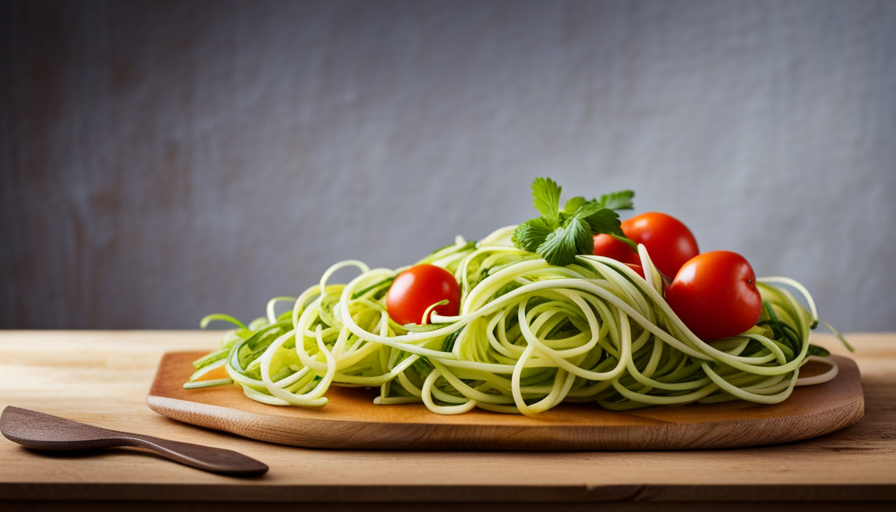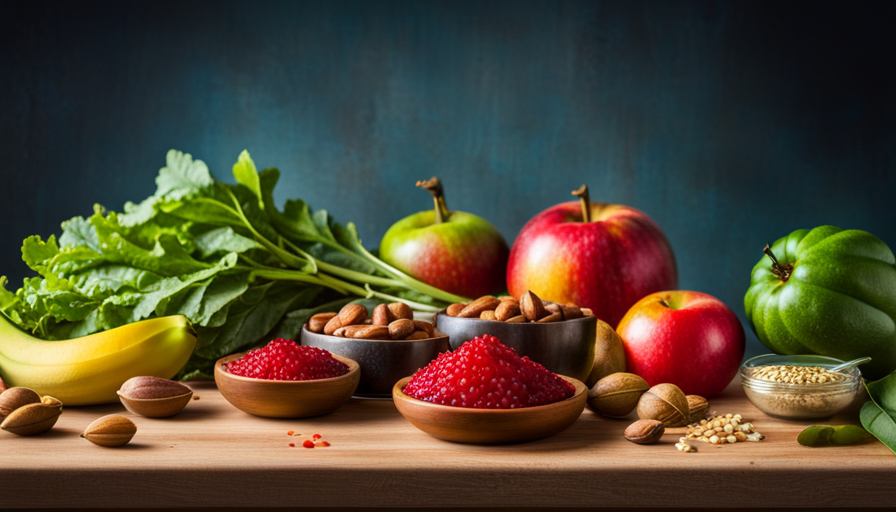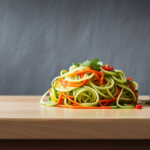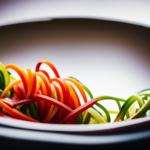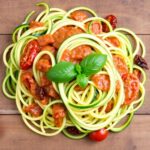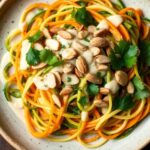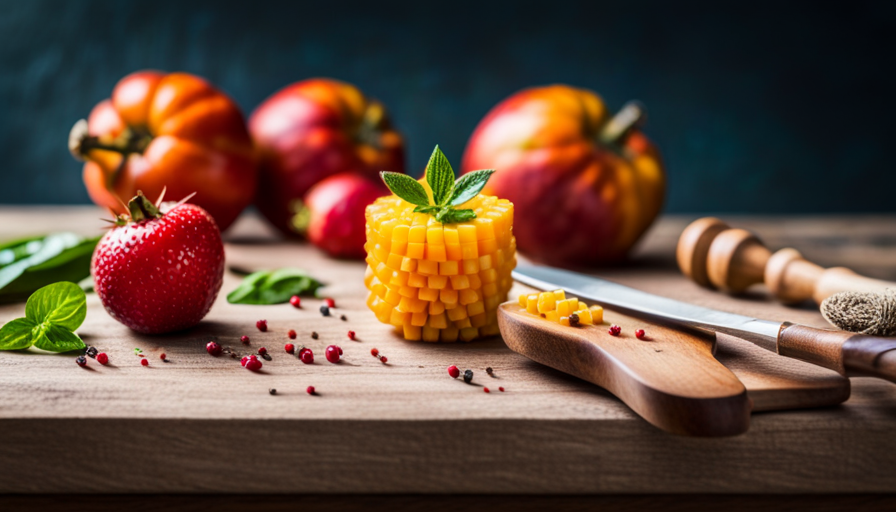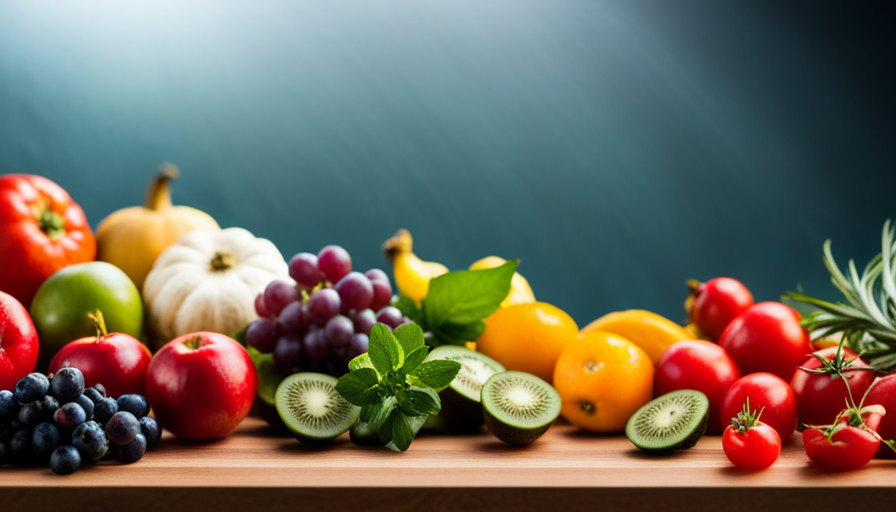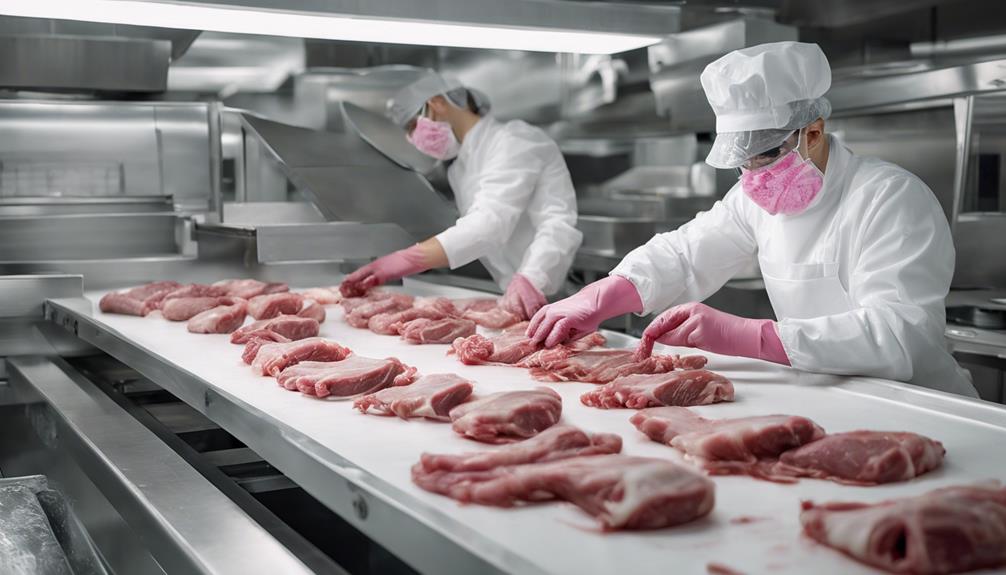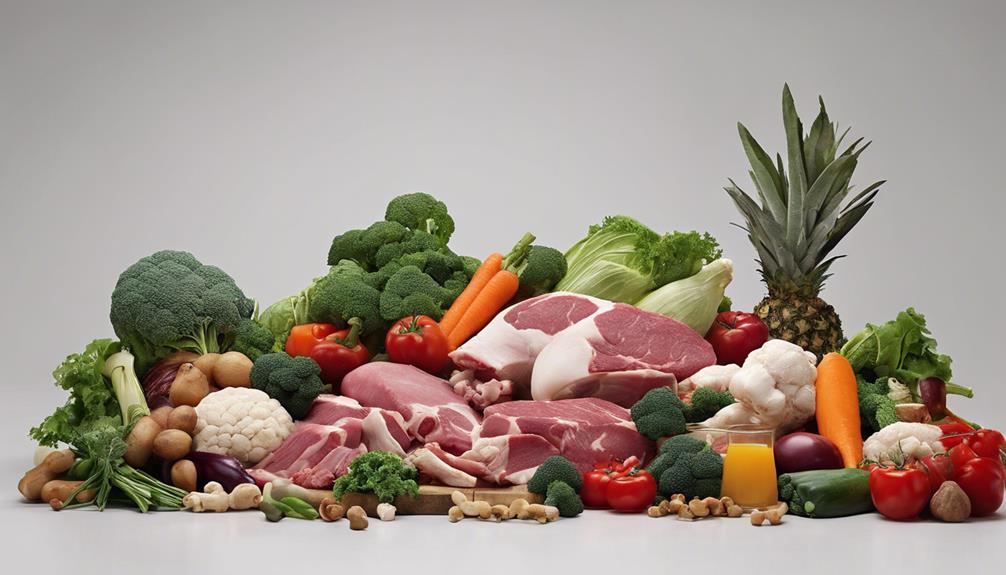So, you believe you’re familiar with noodles? Get prepared to be amazed because I’m going to show you a whole new level of pasta excellence – raw food diet noodles.
Now, you may be thinking, ‘Wait, raw noodles? Isn’t that just another health fad?’ Oh, my friend, let me assure you, these noodles are anything but ordinary.
Raw food diet noodles are noodles made from uncooked vegetables and fruits, packed with all the nutrients and flavors nature has to offer. They are created using innovative techniques that preserve the raw ingredients’ natural goodness, giving you a truly unique and wholesome dining experience.
But it doesn’t stop there – these noodles also come in a variety of types, each with its own distinctive taste and texture.
In this article, we’ll dive deep into the world of raw food diet noodles, exploring their nutritional benefits, different types, and creative ways to use them in recipes. We’ll also address common concerns and questions, and even take a look at the global influence of these noodle wonders.
So, put on your apron and get ready to embrace the raw food lifestyle – noodles style!
Key Takeaways
- Raw food diet noodles are made from uncooked vegetables and fruits, preserving their natural goodness and nutrients.
- They offer increased nutrient intake compared to traditional pasta noodles.
- Spiralized vegetable noodles can help with weight management by making you feel fuller for longer.
- Incorporating spiralized vegetable noodles into your diet can have significant health benefits.
Understanding the Basics of Raw Food Diet Noodles
Raw food diet noodles are made from fresh, uncooked vegetables that have been spiralized into long, thin strands. Spiralizing techniques are used to transform vegetables like zucchini, carrots, and sweet potatoes into noodle-like shapes. This process involves using a spiralizer or a vegetable peeler to create thin strips that resemble traditional pasta noodles.
One of the benefits of raw food diet noodles is that they can be marinated and seasoned to add flavor and variety to the dish. Marinating the noodles in a mixture of olive oil, lemon juice, and herbs can enhance their taste and texture. Additionally, seasoning with spices and herbs such as garlic, basil, or chili flakes can elevate the flavor profile of the noodles.
By using fresh vegetables and incorporating various seasonings, raw food diet noodles offer a nutritious and satisfying alternative to traditional pasta. They’re low in calories, packed with vitamins and minerals, and provide a good source of fiber. Moreover, they’re a great way to incorporate more vegetables into your diet.
Now that we understand the basics of raw food diet noodles, let’s delve into how they’re made without the need for cooking.
How Raw Food Diet Noodles are Made
To experience the full potential of these tantalizing strands, you’ll be amazed at how effortlessly you can create these wholesome and satisfying noodle alternatives.
Raw food diet noodles are typically made using spiralizing techniques. This involves turning vegetables like zucchini, carrots, or sweet potatoes into long, thin strands resembling traditional pasta. You can do this using a spiralizer or a julienne peeler, creating a versatile base for a variety of dishes.
Once the vegetables are spiralized, they can be marinated and seasoned to enhance their flavor. Common marinades include olive oil, lemon juice, and herbs, while popular seasonings include garlic, salt, and pepper. These additions can add depth and complexity to the noodles, making them even more enjoyable to eat.
The marinating process allows the flavors to infuse into the noodles, making them tastier and more satisfying. It also helps to soften the texture, making the noodles easier to chew and digest. Additionally, marinating the noodles can help to tenderize tougher vegetables, making them more palatable.
With the noodles prepared, you can now move on to understanding the nutritional benefits of raw food diet noodles without skipping a beat.
The Nutritional Benefits of Raw Food Diet Noodles
Spiralized vegetable noodles offer a multitude of health benefits that can enhance your overall well-being. These raw food diet noodles aren’t just delicious and versatile, but they’re also packed with essential nutrients that can support a healthy lifestyle.
Here are some superfood benefits of incorporating spiralized vegetable noodles into your diet:
-
Increased nutrient intake: Spiralized vegetable noodles are made from fresh, raw vegetables, so they retain more of their natural nutrients compared to traditional pasta noodles.
-
Weight management: These noodles are low in calories and high in fiber, which can help you feel fuller for longer and prevent overeating.
-
Improved digestion: The high fiber content in spiralized vegetable noodles promotes a healthy digestive system and can alleviate digestive issues like bloating and constipation.
-
Enhanced nutrient absorption: The raw nature of these noodles allows your body to better absorb the vitamins and minerals present in the vegetables.
-
Reduced inflammation: Many vegetables used for spiralized noodles, such as zucchini and carrots, are rich in antioxidants that can help reduce inflammation in the body.
Incorporating spiralized vegetable noodles into your diet can have significant health implications, ranging from improved digestion to weight management. By exploring different types of raw food diet noodles, you can discover a variety of flavors and textures that’ll keep your taste buds satisfied while nourishing your body.
Exploring Different Types of Raw Food Diet Noodles
By incorporating a variety of vibrant vegetables into your meals, you can unleash a world of delicious and nutrient-rich alternatives to traditional pasta. When following a raw food diet, noodles made from vegetables are a popular choice. These noodles are created using spiralizing techniques that transform vegetables like zucchini, carrots, and sweet potatoes into long, thin strands that resemble traditional pasta.
To understand the taste and texture of different raw food diet noodles, let’s compare three popular options:
| Vegetable | Taste | Texture |
|---|---|---|
| Zucchini | Mild and | Crisp and |
| slightly | crunchy | |
| sweet | ||
| Carrots | Sweet and | Firm and |
| earthy | slightly | |
| crunchy | ||
| Sweet | Sweet and | Soft and |
| Potatoes | starchy | slightly |
| chewy |
These are just a few examples, as the possibilities are endless when it comes to raw food diet noodles. By experimenting with different vegetables and spiralizing techniques, you can find the perfect combination of taste and texture that suits your preferences.
In the next section, we will explore creative ways to use raw food diet noodles in recipes, allowing you to expand your culinary horizons without sacrificing taste or nutrition.
Creative Ways to Use Raw Food Diet Noodles in Recipes
Get ready to elevate your meals to a whole new level of culinary delight with these innovative ways to incorporate nutrient-rich vegetable strands into your recipes. Spiralized vegetable noodles are a staple in the raw food diet, offering a delicious and healthy alternative to traditional pasta. Not only are they low in calories and carbohydrates, but they’re also packed with essential vitamins, minerals, and fiber.
There are countless raw food diet noodle recipes that let you get creative in the kitchen. One popular option is to use zucchini noodles as a base for a refreshing and light salad. Simply toss the noodles with a homemade dressing, some fresh herbs, and your favorite vegetables for a quick and nutritious meal. Another idea is to use spiralized sweet potato noodles instead of traditional noodles in a stir-fry. The sweet and savory combination is sure to please your taste buds.
Incorporating spiralized vegetable noodles into your recipes not only adds an extra dose of nutrients but also brings a fun and unique twist to your meals. So go ahead and experiment with different vegetables and flavors to create delicious and satisfying dishes. Now, let’s move on to some helpful tips for preparing and cooking raw food diet noodles.
Tips for Preparing and Cooking Raw Food Diet Noodles
When it comes to preparing and cooking raw food diet noodles, there are a few key points to keep in mind. First, mastering spiralizing techniques is essential for creating the perfect noodle shape.
Additionally, marinating and seasoning the noodles can add depth and flavor to the dish.
Lastly, deciding between raw or lightly cooked options will depend on personal preference and desired texture. By understanding these tips, you can make the most out of your raw food diet noodles and create delicious and satisfying meals.
Spiralizing Techniques
If you really want to take your spiralizing skills to the next level, you’ve got to try out these mind-blowing techniques for creating the most jaw-dropping raw food diet noodles you’ve ever seen. Spiralizing techniques are a game-changer when it comes to preparing raw food diet noodles.
Here are some benefits of using raw food diet noodles:
- They’re packed with nutrients and enzymes that are often lost during cooking.
- They add vibrant colors and textures to your dishes.
- They’re a great way to incorporate more vegetables into your diet.
- They can be used as a healthy alternative to traditional pasta.
By mastering these spiralizing techniques, you can create beautiful and delicious raw food diet noodles that’ll impress everyone.
Now, let’s move on to the next section about marinating and seasoning your noodles to enhance their flavors.
Marinating and Seasoning
To truly elevate your spiralized creations, you must explore the art of marinating and seasoning your veggie noodles. Marinating techniques can add depth and complexity to the flavors of your raw food diet noodles. You can marinate your noodles in a variety of ways, such as using a mixture of lemon juice, olive oil, and herbs for a refreshing and light taste. Another option is to use soy sauce, sesame oil, and ginger for an Asian-inspired flavor profile. Additionally, you can experiment with different seasoning options to enhance the taste of your noodles. Sprinkling some sea salt and black pepper can provide a simple yet satisfying flavor. Other options include adding spices like paprika or chili powder for a kick of heat. By marinating and seasoning your veggie noodles, you can create delicious and flavorful dishes. Now, let’s delve into the next section about raw vs. lightly cooked options.
Raw vs. Lightly Cooked Options
Explore the different ways you can prepare your veggie noodles, whether you prefer them raw or lightly cooked, to discover new flavors and textures.
When it comes to raw vs. lightly cooked options for your noodles, there are pros and cons to consider. Raw food diet noodles offer the advantage of retaining more nutrients and enzymes since they’re not exposed to heat. They also provide a crunchy texture and vibrant color. On the other hand, lightly cooking your veggie noodles can make them easier to digest and enhance their flavor. Lightly cooked noodles still retain some of their nutritional value while offering a softer texture.
Ultimately, the choice between raw and lightly cooked noodles depends on personal preference and dietary needs.
Transitioning into the next section, incorporating raw food diet noodles into a balanced diet can provide a variety of benefits.
Incorporating Raw Food Diet Noodles into a Balanced Diet
When it comes to incorporating raw food diet noodles into a balanced diet, there are a few key points to consider. First, it’s important to pair these noodles with protein sources to ensure a well-rounded meal. This can be done by adding tofu, tempeh, or even some cooked legumes to the dish.
Secondly, adding fresh vegetables and herbs can enhance the nutritional profile and flavor of the meal.
Lastly, it’s crucial to balance nutritional needs by incorporating a variety of nutrient-dense foods and ensuring adequate intake of essential vitamins and minerals.
Pairing with Protein Sources
For a well-rounded meal, you can pair your raw food diet noodles with a variety of protein sources. One option is tofu, which contains an impressive 20 grams of protein per 100 grams. You can slice or cube tofu and add it to your raw food noodles for a satisfying and protein-rich dish.
Another great option is tempeh, a fermented soy product that offers about 19 grams of protein per 100 grams. You can marinate and grill tempeh to add a delicious smoky flavor to your noodles.
Additionally, you can include edamame, which provides around 11 grams of protein per 100 grams. These protein-rich options not only enhance the nutritional value of your meal but also add texture and flavor.
Now, let’s explore the next section about adding fresh vegetables and herbs to complement your raw food diet noodles.
Adding Fresh Vegetables and Herbs
To create a vibrant and flavorful dish, you can elevate your meal by incorporating an array of fresh vegetables and aromatic herbs. Adding fresh herbs to your raw food diet noodles not only enhances the taste, but also adds a burst of nutrients.
Fresh herbs like basil, cilantro, parsley, and mint can provide unique flavor combinations that complement the raw noodles perfectly. For instance, a combination of fresh basil and cherry tomatoes can create a refreshing and summery taste, while cilantro and lime can add a zesty kick to your noodles.
Experimenting with different herbs and vegetables can open up a world of possibilities for your raw food diet. By incorporating these fresh ingredients, you can create a balanced and nutritious meal that satisfies both your taste buds and your health needs.
Transitioning into the next section about balancing nutritional needs, it’s important to consider the protein sources that complement your vegetable and herb choices.
Balancing Nutritional Needs
Looking to maintain a well-rounded and nourishing lifestyle? Let’s dive into the art of balancing your nutritional needs. One way to achieve this balance is by incorporating raw food diet noodles into your diet. These noodles are made from vegetables like zucchini, carrots, or kelp, providing a healthy alternative to traditional pasta. They are low in calories and packed with essential nutrients, including fiber, vitamins, and minerals. To highlight the nutritional benefits, here’s a table comparing the nutrients found in 100 grams of raw food diet noodles versus traditional pasta:
| Nutrient | Raw Food Diet Noodles | Traditional Pasta |
|---|---|---|
| Calories | 15 | 131 |
| Fiber | 1.5g | 2g |
| Vitamin C | 15% of the RDI | 0% |
By incorporating raw food diet noodles into a balanced diet, you can enjoy a variety of flavors while meeting your nutritional needs. Now, let’s address common concerns and questions about raw food diet noodles.
Addressing Common Concerns and Questions about Raw Food Diet Noodles
When it comes to incorporating raw food diet noodles into a balanced diet, there are certain concerns and questions that often arise.
First and foremost, food safety and storage is a key consideration. It’s important to ensure that these noodles are handled and stored properly to minimize the risk of foodborne illnesses.
Additionally, addressing allergies and dietary restrictions is crucial, as many individuals may have specific dietary needs or restrictions that need to be taken into account.
Lastly, taste and texture comparisons are often a topic of discussion, as people want to know how these raw food diet noodles compare to traditional cooked noodles in terms of flavor and texture.
Food Safety and Storage
Storing raw food diet noodles properly ensures their safety and freshness. Food safety is a crucial aspect of any diet, and it’s no different for raw food diet noodles.
To maintain their quality and minimize the risk of foodborne illnesses, it’s important to follow proper storage guidelines. Firstly, make sure to store raw food diet noodles in a clean, airtight container to prevent contamination. They should be kept in the refrigerator, preferably in the vegetable drawer, at a temperature below 40°F (4°C).
It’s also essential to consume them within a few days to maintain their freshness. By following these guidelines, you can ensure the safety and quality of your raw food diet noodles.
Moving on to the next section about allergies and dietary restrictions…
Allergies and Dietary Restrictions
To ensure your safety and accommodate your dietary restrictions, it’s important to be mindful of any allergies you may have when enjoying a meal. Food allergies can range from mild to severe, and it’s crucial to know what ingredients are in your food to avoid any potential reactions.
When it comes to raw food diet noodles, there are plenty of options available for those with allergies. Many raw food noodles are made from vegetables such as zucchini or carrots, which are naturally vegan and gluten-free. These noodles can be a great alternative for individuals with allergies to wheat or other grains. Additionally, there are also raw food noodles made from kelp or seaweed, which provide a unique taste and texture.
Transitioning into the next section about taste and texture comparisons, it’s important to note that raw food noodles can offer a refreshing and light alternative to traditional pasta dishes.
Taste and Texture Comparisons
If you’re curious about how raw food noodle alternatives compare in terms of taste and texture, you’re in for a delightful surprise! Raw food diet noodles offer a unique and refreshing twist to traditional pasta options.
When it comes to taste comparison, raw food noodles can vary depending on the ingredients used. Some alternatives, like zucchini noodles or spiralized carrots, have a mild and neutral taste that allows them to absorb the flavors of sauces or dressings. Others, such as kelp noodles, have a slightly salty and oceanic taste.
Texture-wise, raw food noodles offer a crisp and crunchy bite, which can be a refreshing change from the softness of cooked pasta. Their texture also holds up well when tossed with sauces or mixed into salads.
Exploring the global influence of raw food diet noodles opens up a world of exciting culinary possibilities.
Exploring the Global Influence of Raw Food Diet Noodles
When it comes to raw food diet noodles, you’ll be amazed at the global influence they have and the diverse flavors they offer. Raw food diet noodles are not just limited to one cuisine or culture, but are enjoyed by people all around the world. Here are some ways in which raw food diet noodles have made their mark globally:
-
Asian Influence: Raw food diet noodles have a strong presence in Asian cuisines such as Japanese, Chinese, and Thai. These cultures have perfected the art of making raw food diet noodles and have developed unique marinating techniques to enhance the flavors.
-
Italian Inspiration: Raw food diet noodles have also found their way into Italian cuisine, with dishes like zucchini spaghetti and carrot fettuccine. These raw pasta alternatives offer a healthy twist to traditional Italian dishes.
-
Mexican Flair: Raw food diet noodles have even made their way into Mexican cuisine. Zucchini noodles, or ‘zoodles,’ are commonly used in Mexican-inspired dishes like raw taco salads and enchilada bowls.
-
Middle Eastern Fusion: Raw food diet noodles have been incorporated into Middle Eastern cuisine as well. Raw kelp noodles are often used in salads and wraps, adding a crunchy texture and a unique flavor.
-
Mediterranean Delights: Raw food diet noodles have also found their place in Mediterranean dishes. Raw cucumber noodles are a popular choice for creating refreshing salads and pasta alternatives.
With such a wide range of flavors and influences, raw food diet noodles offer a delicious and healthy alternative to traditional noodles. Embracing the raw food lifestyle with noodles allows you to explore different cuisines and enjoy the health benefits they provide.
Embracing the Raw Food Lifestyle with Noodles
Little did I know that by indulging in the raw food lifestyle with noodles, I would unlock a whole new world of culinary delights. One of the key tools for creating raw food noodles is a spiralizer. This handy gadget allows me to transform a variety of vegetables into long, thin strands that mimic the texture of traditional noodles. There are many spiralizer options available, ranging from handheld versions to electric models, making it easy to find one that suits my needs.
When it comes to raw food noodles, there are also alternative options to consider. Zucchini noodles, also known as zoodles, are a popular choice. They have a mild flavor and a tender texture that makes them a great substitute for traditional pasta. Another alternative is kelp noodles, which are made from seaweed and have a slightly crunchy texture. These noodles are low in calories and carbohydrates, making them a favorite among those following a raw food diet.
The beauty of embracing the raw food lifestyle with noodles is that it allows me to enjoy a wide variety of flavors and textures while still adhering to my dietary preferences. Whether I’m in the mood for a light and refreshing zoodle salad or a hearty bowl of kelp noodle soup, there are endless possibilities to explore. So, if you’re looking to add some excitement to your raw food diet, don’t be afraid to venture into the world of raw food noodles.
Frequently Asked Questions
Can raw food diet noodles be cooked?
Raw food diet noodles can be cooked, but it goes against the principles of a raw food diet. Raw food diet noodles are typically made from vegetables like zucchini or carrots that are spiralized into noodle shapes. They are consumed raw to preserve their natural enzymes and nutrients. Cooking them can denature these beneficial components.
However, if you prefer cooked noodles, there are plenty of alternative options available, such as whole grain or gluten-free noodles, that can still be incorporated into a raw food diet.
Are raw food diet noodles gluten-free?
Raw food diet noodles can be gluten-free, depending on the ingredients used. These noodles are typically made from vegetables like zucchini or carrots, which are spiralized or thinly sliced to mimic the texture of traditional noodles.
While they offer nutritional benefits like being low in calories and high in fiber, some potential drawbacks include a lack of certain nutrients and a different taste and texture compared to regular noodles.
Can raw food diet noodles be stored for a long period of time?
Yes, raw food diet noodles can be stored for a long period of time. Proper storage is important to maintain their quality and nutritional benefits. To maximize their shelf life, it’s best to store them in an airtight container in a cool, dry place.
It’s also recommended to check the expiration date on the packaging. However, it’s important to note that the storage time may vary depending on the specific brand and type of raw food diet noodles.
Are raw food diet noodles suitable for individuals with certain dietary restrictions?
Are raw food diet noodles suitable for individuals with certain dietary restrictions?
With their numerous nutritional benefits, raw food diet noodles are a great choice for those with dietary restrictions. They’re packed with vitamins, minerals, and fiber, providing a healthy alternative to traditional pasta. Plus, they can be used in a variety of delicious raw food diet noodle recipes, such as zucchini noodles with basil pesto or carrot noodles with ginger sesame sauce.
So, why not give them a try and boost your health while enjoying a tasty meal?
Can raw food diet noodles be used as a substitute for traditional pasta in recipes?
Raw food diet noodles can indeed be used as a substitute for traditional pasta in recipes. They offer a variety of nutritional benefits, including being low in calories and carbohydrates, and high in fiber and vitamins. These noodles are typically made from vegetables like zucchini or carrots, and can be prepared using methods such as spiralizing or julienning. They provide a healthy alternative for those looking to incorporate more raw, plant-based options into their diet.
Are Raw Food Diet Noodles and Raw Food Noodles the Same Thing?
Raw food noodles explained: Raw food diet noodles are made from vegetables like zucchini, carrots, or sweet potatoes, while raw food noodles refer to noodles made from uncooked ingredients. Both are part of a raw food diet, but raw food noodles can include a wider variety of ingredients.
Conclusion
In conclusion, raw food diet noodles offer a delicious and nutritious alternative to traditional pasta. They’re made from a variety of vegetables, such as zucchini or carrots, and can be easily incorporated into a balanced diet.
With their high vitamin and mineral content, raw food diet noodles provide a healthy and satisfying meal option. So why not embrace the raw food lifestyle and give these noodles a try?
Remember, variety’s the spice of life, and raw food diet noodles can add a flavorful twist to your culinary adventures.

